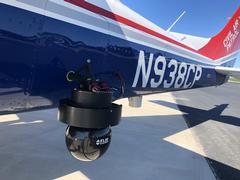Staff Sections
Main Content
NC Wing of Civil Air Patrol Gets FLIR Cameras
A forward-looking infrared (FLIR 8500) camera installed on a NC Wing aircraft. Photo Credit: Lt Col Chris Bailey, CAP (click image to view full size)
Forward-looking infrared cameras installed on two Wing aircraft
10/23/2019–BURLINGTON, NC–The NC Wing of Civil Air Patrol (CAP) has received two new forward-looking infrared (FLIR 8500) cameras for our airplanes. The FLIR cameras use a thermographic camera that senses infrared radiation, typically emitted from a heat source, to create an image.
Acquiring the specialized cameras was a joint project between NC Emergency Management (NCEM) and the NC Wing of CAP. NCEM is providing the funding for two CAP aircraft to be outfitted with the cameras. Installation of the FLIR cameras is presently underway on these planes.
The FLIR cameras will be used on a variety of missions including Search and Rescue (SAR), Disaster Relief and Mitigation, Homeland Security, Aerial Imagery, and Aerial Reconnaissance of Traffic and Ground Conditions. Currently there are only three FLIR cameras available for SAR in North Carolina and two of them are now on CAP airplanes.
Once installation of the cameras is complete, one of the FLIR-equipped airplanes will be hangared at the Triangle North Executive Airport in Louisburg and the other will be hangared at the Asheville Regional Airport. This geographic diversity will make it easier for the NC Wing to respond to agencies’ requests for aid across North Carolina.
Capt Scott Stevens, NC Wing’s Director of Emergency Services, stated that, “getting the FLIR cameras on our aircraft greatly increases the Wing’s Emergency Services capabilities. Capt Ben Watkins, CAP Manager for NCEM, and Lt Col Chris Bailey, the NC Wing’s Deputy Chief of Staff, worked tirelessly to make this happen and citizens across the state will benefit for years to come. Getting these cameras is truly a game-changer for us and it is going to help solidify CAP's position as a major player in search and rescue in North Carolina."
Specialized training will be required to operate the FLIR camera and Lt Col Chris Bailey successfully obtained funding to provide this training. The NC Wing is currently developing a Task Book and SQTR so that CAP members can train to become a Thermal Imaging System Operator (TISO).
During a mission, the TISO will operate the camera from the Mission Scanner (rear) seat. Both the TISO and the Mission Observer will be able to view the images that the camera is seeing.
While there will be a learning curve and it will take time to get members trained and proficient as TISO’s, this is a very exciting development for the NC Wing that will significantly enhance our ability to serve our communities and state.
Sub Content
- My Account
- Member Login
- Register for an account
Search
- Recent Articles
- Cunningham Field Composite Squadron Hosts Air Operations Training and Familiarization
- NC Wing CyberPatriot Preliminary State Award Winners Announced
- Tar River Composite Squadron Cadets Compete in CyberPatriot Competition
- Civil Air Patrol Remembers Veterans for Christmas
